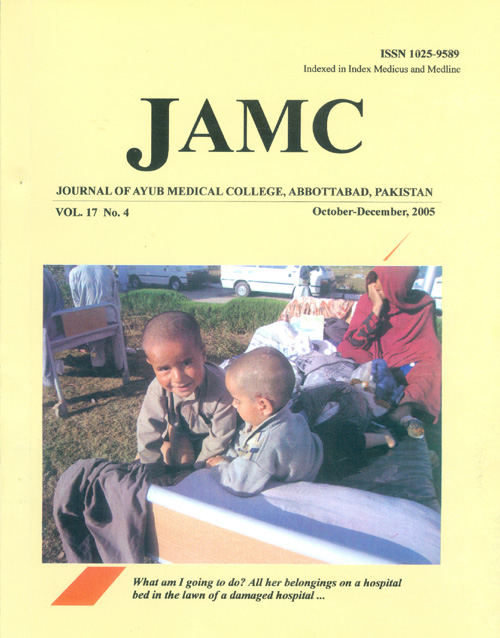FREQUENCY OF IRRITABLE BOWEL SYNDROME IN COLLEGE STUDENTS
Abstract
Background: This study was carried out to investigate the presence of irritable bowel syndrome(IBS) in college students and compare its distribution in the non-medical college and medicalcollege students. Methods: We collected data from 508 students by inviting them to fill out aquestionnaire based on Rome II criteria for the diagnosis of IBS from November 2001 to February2004. Two major cities Karachi and Bahawalpur were selected and it was coordinated by thesection of Gastroenterology, Department of Medicine, Aga Khan University Hospital and Quaide-Azam Medical College, Bahawalpur. Results: A total of 508 subjects with males 43 %(220/508) and female 57 % (288/508) mean age 22 ± 2.8 years responded to the questionnaire.The overall frequency of IBS among college students was 34 % (171/508).There were 41 %(107/263) non-medical college and 26 % (64/245) medical college students with IBS. Abdominalpain was present in 100 % (171/171) with altered frequency of stool in 58 % (100/171) (p< 0.001,OR 12.5, CI 7.9-20.0) of students with IBS. The medical advice was sought by 38 % (65/171) inIBS group with 46 % (30/65) non-medical college school and 54 % (35/65) medical student(p=0.001, OR 1.9, CI 1.3-2.8). Conclusion: IBS is common in younger adult population ofPakistan. Its prevalence is higher in non-medical college students but health care seeking behaviorwas more common in medical students.Key words: Irritable Bowel Syndrome students, youngs, health seeking behaviorReferences
Thompson WG. The functional gastrointestinal bowel
disorders. In: Drossman D, ed. The functional gastrointestinal
disorder. McLean VA: Degnon Associates;1994:117-34.
Thompson WG, Longstreth GF, Drossman DA, Heaton KW,
Irvine EJ, Muller-Lissner SA. Functional bowel disorders and
functional abdominal pain. Gut 1999; 45 Suppl 2: 1143-7.
Heaton KW, O’Donnell LJD, Braddon FEM Mountford RA,
Hugh AO, Cripps PJ. Symptoms of irritable bowel syndrome
in a British urban community: Consulters and non-consulters.
Gastroenterology 1992; 102: 1962-7.
Jones R, Lydeard S. Irritable bowel syndrome in the general
population. BMJ 1992; 304: 87-90.
Fielding JF. The irritable bowel syndrome. Part I: clinical
spectrum. Clin Gastroenterology 1977; 6: 607-22.
Danivat D, Tankeyoon M, Sriratanaban A. Prevalence of
irritable bowel syndrome in a non-Western population. BMJ
; 296: 1710-4.
Ho KY, Kang JK, Seow A. Prevalence of gastrointestinal
symptoms in a multiracial Asian population with particular
reference to reflux-type symptoms. Am J Gastroenterol 1998;
: 1816-22.
Kwan AC, Hu WH, Chan YK, Yeung YW, Lai TS, Yuen H.
Prevalence of irritable bowel syndrome in Hong Kong. J
Gastroenterol Hepatol 2002; 17: 1180-6.
Jafri W, Yakoob J, Jafri N, Maloni M, Hamid S, Shah HA, et
al. Irritable bowel syndrome in health care personnel in
Pakistan. J Pak Med Assoc 2003; 53: 405-7.
Jafri W, Yakoob J, Jafri N, Maloni M, Shah HA, Hamid S, et
al. Diagnosis of Irritable Bowel Syndrome in patients
evaluated for organic bowel pathology. J Coll Phys Surg Pak
;14:438-9.
Drossman DA, Thompson WG. The irritable bowel syndrome:
Review and a graduated multi-component treatment approach.
Ann Intern Med 1992;116:1009-16.
Mathur A, Tandon BN, Prakash OM. Irritable colon
syndrome. J Indian Med Assoc 1966;46:651-5.
Syed EU, Mehmud S, Atiq R. Clinical and demographic
characteristics of psychiatric inpatients admitted via
emergency and non-emergency routes at a university hospital
in Pakistan. J Pak Med Assoc 2002;52:456-9.
CONCLUSION
There is a high frequency of Irritable Bowel
Syndrome in non-medical college students but health
seeking behavior is more common in medical
students. However, the results of this study need to be
confirmed in a larger multi center study.
Shaikh BT, Kahloon A, Kazmil M, Khalid H, Nawaz K, Khan
NA, et al. Stress management in medical students. J Coll
Physicians Surg Pak 2004;14:306-9.
Talley NJ, Phillips SF, Bruce BK, Twomey CK, Zinmeister
AR, Melton LJ 3rd. Relation between personality
characteristics and symptoms in non-ulcer dyspepsia and IBS.
Gastroenterology1990;99:327-33.
Issue
Section
License
Journal of Ayub Medical College, Abbottabad is an OPEN ACCESS JOURNAL which means that all content is FREELY available without charge to all users whether registered with the journal or not. The work published by J Ayub Med Coll Abbottabad is licensed and distributed under the creative commons License CC BY ND Attribution-NoDerivs. Material printed in this journal is OPEN to access, and are FREE for use in academic and research work with proper citation. J Ayub Med Coll Abbottabad accepts only original material for publication with the understanding that except for abstracts, no part of the data has been published or will be submitted for publication elsewhere before appearing in J Ayub Med Coll Abbottabad. The Editorial Board of J Ayub Med Coll Abbottabad makes every effort to ensure the accuracy and authenticity of material printed in J Ayub Med Coll Abbottabad. However, conclusions and statements expressed are views of the authors and do not reflect the opinion/policy of J Ayub Med Coll Abbottabad or the Editorial Board.
USERS are allowed to read, download, copy, distribute, print, search, or link to the full texts of the articles, or use them for any other lawful purpose, without asking prior permission from the publisher or the author. This is in accordance with the BOAI definition of open access.
AUTHORS retain the rights of free downloading/unlimited e-print of full text and sharing/disseminating the article without any restriction, by any means including twitter, scholarly collaboration networks such as ResearchGate, Academia.eu, and social media sites such as Twitter, LinkedIn, Google Scholar and any other professional or academic networking site.









